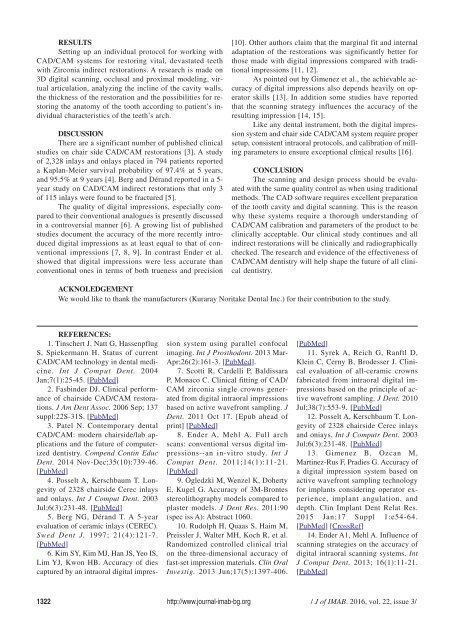JofIMAB-2016-vol22-issue3
You also want an ePaper? Increase the reach of your titles
YUMPU automatically turns print PDFs into web optimized ePapers that Google loves.
RESULTS<br />
Setting up an individual protocol for working with<br />
CAD/CAM systems for restoring vital, devastated teeth<br />
with Zirconia indirect restorations. A research is made on<br />
3D digital scanning, occlusal and proximal modeling, virtual<br />
articulation, analyzing the incline of the cavity walls,<br />
the thickness of the restoration and the possibilities for restoring<br />
the anatomy of the tooth according to patient’s individual<br />
characteristics of the teeth’s arch.<br />
DISCUSSION<br />
There are a significant number of published clinical<br />
studies on chair side CAD/CAM restorations [3]. A study<br />
of 2,328 inlays and onlays placed in 794 patients reported<br />
a Kaplan-Meier survival probability of 97.4% at 5 years,<br />
and 95.5% at 9 years [4]. Berg and Dérand reported in a 5-<br />
year study on CAD/CAM indirect restorations that only 3<br />
of 115 inlays were found to be fractured [5].<br />
The quality of digital impressions, especially compared<br />
to their conventional analogues is presently discussed<br />
in a controversial manner [6]. A growing list of published<br />
studies document the accuracy of the more recently introduced<br />
digital impressions as at least equal to that of conventional<br />
impressions [7, 8, 9]. In contrast Ender et al.<br />
showed that digital impressions were less accurate than<br />
conventional ones in terms of both trueness and precision<br />
[10]. Other authors claim that the marginal fit and internal<br />
adaptation of the restorations was significantly better for<br />
those made with digital impressions compared with traditional<br />
impressions [11, 12].<br />
As pointed out by Gimenez et al., the achievable accuracy<br />
of digital impressions also depends heavily on operator<br />
skills [13]. In addition some studies have reported<br />
that the scanning strategy influences the accuracy of the<br />
resulting impression [14, 15].<br />
Like any dental instrument, both the digital impression<br />
system and chair side CAD/CAM system require proper<br />
setup, consistent intraoral protocols, and calibration of milling<br />
parameters to ensure exceptional clinical results [16].<br />
CONCLUSION<br />
The scanning and design process should be evaluated<br />
with the same quality control as when using traditional<br />
methods. The CAD software requires excellent preparation<br />
of the tooth cavity and digital scanning. This is the reason<br />
why these systems require a thorough understanding of<br />
CAD/CAM calibration and parameters of the product to be<br />
clinically acceptable. Our clinical study continues and all<br />
indirect restorations will be clinically and radiographically<br />
checked. The research and evidence of the effectiveness of<br />
CAD/CAM dentistry will help shape the future of all clinical<br />
dentistry.<br />
ACKNOLEDGEMENT<br />
We would like to thank the manufacturers (Kuraray Noritake Dental Inc.) for their contribution to the study.<br />
REFERENCES:<br />
1. Tinschert J, Natt G, Hassenpflug<br />
S, Spiekermann H. Status of current<br />
CAD/CAM technology in dental medicine.<br />
Int J Comput Dent. 2004<br />
Jan;7(1):25-45. [PubMed]<br />
2. Fasbinder DJ. Clinical performance<br />
of chairside CAD/CAM restorations.<br />
J Am Dent Assoc. 2006 Sep; 137<br />
suppl:22S-31S. [PubMed]<br />
3. Patel N. Contemporary dental<br />
CAD/CAM: modern chairside/lab applications<br />
and the future of computerized<br />
dentistry. Compend Contin Educ<br />
Dent. 2014 Nov-Dec;35(10):739-46.<br />
[PubMed]<br />
4. Posselt A, Kerschbaum T. Longevity<br />
of 2328 chairside Cerec inlays<br />
and onlays. Int J Comput Dent. 2003<br />
Jul;6(3):231-48. [PubMed]<br />
5. Berg NG, Dérand T. A 5-year<br />
evaluation of ceramic inlays (CEREC).<br />
Swed Dent J. 1997; 21(4):121-7.<br />
[PubMed]<br />
6. Kim SY, Kim MJ, Han JS, Yeo IS,<br />
Lim YJ, Kwon HB. Accuracy of dies<br />
captured by an intraoral digital impression<br />
system using parallel confocal<br />
imaging. Int J Prosthodont. 2013 Mar-<br />
Apr;26(2):161-3. [PubMed].<br />
7. Scotti R, Cardelli P, Baldissara<br />
P, Monaco C. Clinical fitting of CAD/<br />
CAM zirconia single crowns generated<br />
from digital intraoral impressions<br />
based on active wavefront sampling. J<br />
Dent. 2011 Oct 17. [Epub ahead of<br />
print] [PubMed]<br />
8. Ender A, Mehl A. Full arch<br />
scans: conventional versus digital impressions--an<br />
in-vitro study. Int J<br />
Comput Dent. 2011;14(1):11-21.<br />
[PubMed]<br />
9. Ogledzki M, Wenzel K, Doherty<br />
E, Kugel G. Accuracy of 3M-Brontes<br />
stereolithography models compared to<br />
plaster models. J Dent Res. 2011:90<br />
(spec iss A): Abstract 1060.<br />
10. Rudolph H, Quaas S, Haim M,<br />
Preissler J, Walter MH, Koch R, et al.<br />
Randomized controlled clinical trial<br />
on the three-dimensional accuracy of<br />
fast-set impression materials. Clin Oral<br />
Investig. 2013 Jun;17(5):1397-406.<br />
[PubMed]<br />
11. Syrek A, Reich G, Ranftl D,<br />
Klein C, Cerny B, Brodesser J. Clinical<br />
evaluation of all-ceramic crowns<br />
fabricated from intraoral digital impressions<br />
based on the principle of active<br />
wavefront sampling. J Dent. 2010<br />
Jul;38(7):553-9. [PubMed]<br />
12. Posselt A, Kerschbaum T. Longevity<br />
of 2328 chairside Cerec inlays<br />
and oniays. Int J Computr Dent. 2003<br />
Jul;6(3):231-48. [PubMed]<br />
13. Gimenez B, Ozcan M,<br />
Martinez-Rus F, Pradies G. Accuracy of<br />
a digital impression system based on<br />
active wavefront sampling technology<br />
for implants considering operator experience,<br />
implant angulation, and<br />
depth. Clin Implant Dent Relat Res.<br />
2015 Jan;17 Suppl 1:e54-64.<br />
[PubMed] [CrossRef]<br />
14. Ender A1, Mehl A. Influence of<br />
scanning strategies on the accuracy of<br />
digital intraoral scanning systems. Int<br />
J Comput Dent. 2013; 16(1):11-21.<br />
[PubMed]<br />
1322 http://www.journal-imab-bg.org / J of IMAB. <strong>2016</strong>, vol. 22, issue 3/



